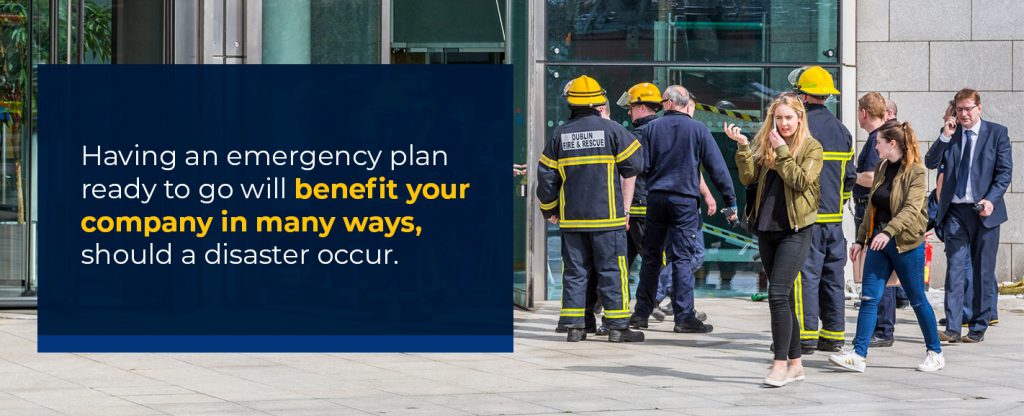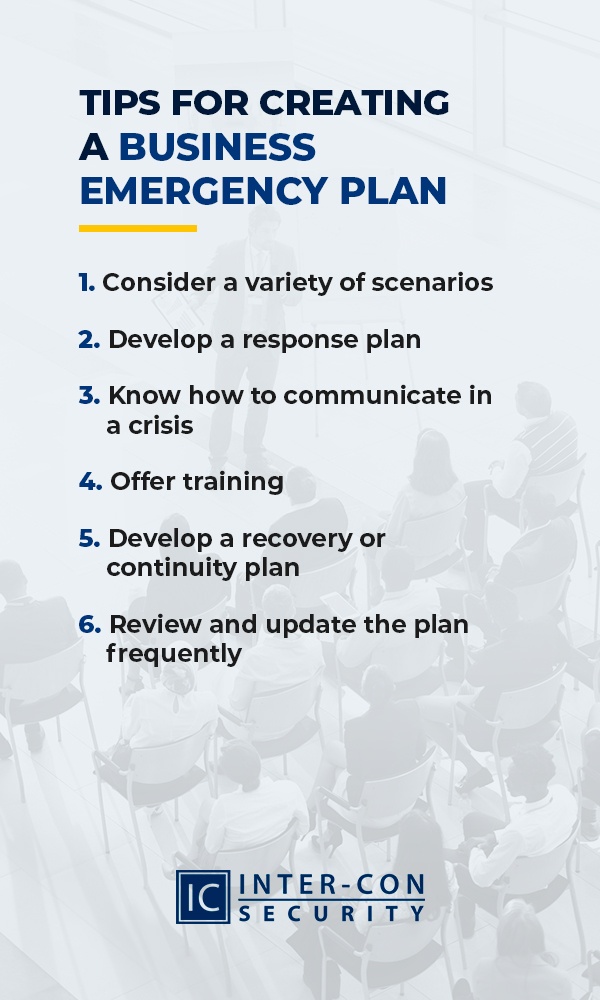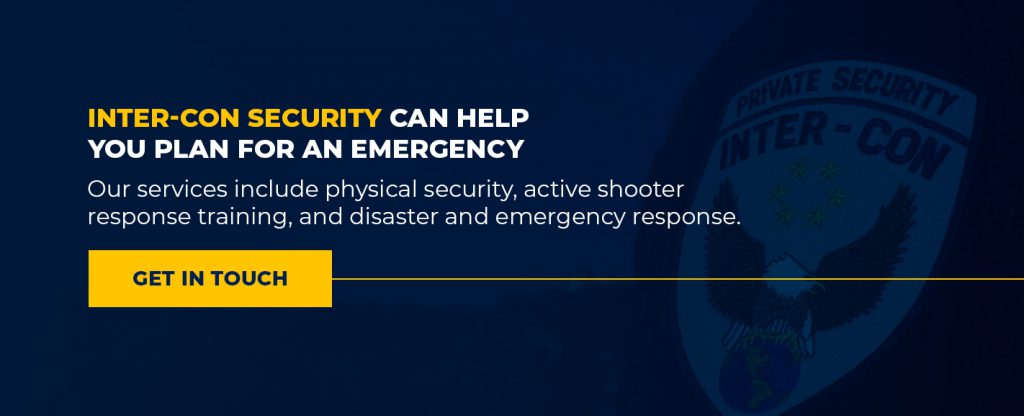What would your business do if a major disaster were to strike? It’s estimated that around one-quarter of businesses would be unable to reopen following a disaster. Although you might not want to consider the possibility of a hurricane, pandemic, security breach, or another type of catastrophe occurring, it pays to be prepared. One way to prepare yourself and your business for any type of emergency is by creating a disaster preparedness plan.
Your company’s disaster preparedness plan should focus on emergency situations that your company is likely to face or that pose a plausible risk to your business. Ideally, the plan will include steps to take in the event of an emergency, as well as steps to take to rebuild and get your company back in operation afterward. Whether you’re about to start a new company or have an existing business that doesn’t have any sort of emergency plan, here’s what you can do to get started.
Why Your Business Needs an Emergency Preparedness Plan

Why should your company create an emergency plan? The primary reason is that disasters and emergency situations happen. Having a plan in place that allows you and your employees to respond quickly and appropriately in an emergency can make a big difference to the fate of your business. Even if the risk of something occurring seems small, it always pays to be prepared.
Benefits of an Emergency Preparedness Plan
Having an emergency plan ready to go will benefit your company in many ways, should a disaster occur. Here are some of the benefits of an emergency preparedness plan:
- Provides guidance on how to respond in the moment: In an emergency or otherwise challenging situation, it can be difficult to decide what to do or how to respond. When your company has a plan, guesswork is taken out of the equation. Everything is mapped out in advance, and roles are assigned to specific individuals, so that people know exactly what to do if a hurricane strikes, a violent intruder arrives, or a major public health disaster occurs.
- Offers your employees protection: Where would your business be without its employees? Creating an emergency plan allows you to protect the people who matter most to your company: your employees. The plan can include directions for them to shelter-in-place, provide guidance on what to do if they need to quickly evacuate, or set up a chain of communication in case information needs to be shared immediately.
- Allows you to make the right preparations: Emergency plans aren’t one-size-fits-all. You can and should custom fit your company’s plan to your business. Focus on creating a response to the situations that are more likely to affect your business. If your company is based in an area that sees a lot of hurricanes throughout the year, then it’s vital that you have a plan in place to respond in case of a hurricane. Companies in areas that don’t see a lot of or any hurricanes are most likely better off focusing on other types of situations, such as what to do in the event of a tornado or a public health crisis.
- Helps your business recover more quickly: Although they can be separate, a business continuity plan is often part of an emergency preparedness plan. With a business continuity plan, your company has a map to guide it as it moves forward and gets back on its feet after a major catastrophe.
Types of Disasters and Emergencies
Disasters can be either naturally occurring, such as weather events, or human-made, such as security breaches. Review the most common types of disasters and emergencies and tailor your business’ plan to include the ones that are most realistic.
- Hurricanes: Hurricanes are accompanied by high winds that can cause significant damage to buildings and materials, as well as injury to people.
- Earthquakes: Although often associated with the West Coast of the U.S., earthquakes can occur across the country. There is the risk of injury to people and damage to structures and property, depending on the strength of the earthquake.
- Fires: Fires can include wildfires, which often occur on the West Coast, as well as fires that are intentionally started or that occur as a result of electrical problems or other issues in a building.
- Floods: Floods can occur after a storm, such as a hurricane or because of an issue with a human-made structure, such as a levy or dam.
- Tornadoes: Like hurricanes, tornadoes are also associated with high, destructive winds. Unlike hurricanes, tornadoes can develop without warning. If your business is in a region where tornadoes are prevalent, having a response plan in place is particularly critical.
- Pandemics and epidemics: Public health situations can be widespread, affecting people across the globe, or they can be locally contained. Although a pandemic or epidemic might not cause physical damage to your business, it can slow your company down, put your employees at risk, or lead to a loss of revenue.
- Data breaches: A data breach can affect your company’s reputation and can lead to a significant loss of revenue, depending on the information that is stolen. Having a plan for responding after a data breach is a must to allow your company to regain the public’s trust.
- Active shooter or violent intruder event: An active shooter or violent intruder event occurs when an individual has the intention of harming people at your place of business, whether they are co-workers or customers. Developing an active shooter response and incorporating it into your emergency plan will allow your company to be prepared in the event of a potentially dangerous situation.
How to Decide What to Focus on With Your Emergency Plan
Ideally, your business emergency plan will focus on the disasters that pose the biggest threat to your company. In the case of natural disasters, it’s usually best to focus on the type of events that are more prevalent in your area. For example, a business based in California might decide to create a plan to respond to an earthquake rather than a hurricane. A company based in Florida will most likely need to have a plan in place for responding to hurricanes.
Even though the threat of some types of disasters, such as pandemics, can seem remote, no matter where your business is located, it’s still a smart idea to have a plan in place for responding to a public health crisis. The odds of one occurring might be very low, but it still pays to be prepared.
Assess How an Emergency Would Affect Your Business
When developing your business emergency plan, one thing to consider is how a particular disaster or situation would impact your company. Not all emergencies are the same — some can have short-term effects, while others might cause longer-lasting complications. Some of the ways a disaster could affect your business include:
- Loss of income: If your company has to close as a result of a public health issue or natural disaster, there is the chance that your business will lose a considerable amount of revenue. Your emergency plan can include a calculation of how much income your business might lose and a plan for making up the income or for getting by without it.
- Higher expenses: A natural disaster might lead to higher costs for your company, such as increased insurance premiums or expensive repair bills. If your team needs to work overtime to get back on track after the situation, your company might also have an elevated payroll.
- Increased employee turnover: Depending on the type of emergency, employees might leave the company, either because they have been forced to move as a result of storm damage or because they didn’t feel they were adequately protected during the event. Your company’s plan should include a roadmap for retaining employees after an event and for providing your team with the attention and support they need to heal after a challenging situation.
- Loss of customers: Customers might feel that they can no longer trust your business after a data breach. If your company has to stop operating for a period after a storm or as a result of a public health situation, your customers might turn to other businesses.

With an awareness of the impacts a disaster could have on your business, you can develop a plan to help it get through a challenging situation and help it survive and thrive.
Tips for Creating a Business Emergency Plan
Developing a disaster preparedness plan for businesses is usually a multi-step process. In addition to considering the type of disasters or emergency situations your company could face, it’s important to consider your different response options. As you create a plan, these tips can help you make sure that it is comprehensive.

1. Consider a Variety of Scenarios
Your business’ response will vary based on the type of situation it finds itself in. Your response to a hurricane will be considerably different from your response to an active shooter or a public health crisis. For that reason, it’s important that you have a detailed response plan for each type of emergency.
As you consider the scenarios that might come up, assess the damage that each one could cause to your company, the risk of a particular scenario occurring, and what you will need to appropriately respond to it.
2. Develop a Response Plan
More likely than not, a response will be required in the event of an emergency. How people at your company respond to a situation depends on the risk and what’s at stake. Generally speaking, there are four ways to respond in the middle of a disaster:
- Evacuate
- Shelter
- Shelter-in-Place
- Lockdown
Before a significant weather event, such as a hurricane, your best option might be to have the building evacuated. Your plan should include details on how to quickly and safely get everyone out of the building and how to confirm that the building has been fully evacuated. It’s also worthwhile to have a map of the building with emergency exits marked and with possible escape routes outlined.
Sheltering and shelter-in-place are similar but are used in different situations. You might ask people in the building to seek shelter if a tornado is on the way. Sheltering usually involves moving away from rooms with windows and finding a place on the interior of the building. In the event of a situation outside of your building, such as a chemical leak, you might need to shelter-in-place to avoid exposure.
If a dangerous person is in the area near your business or in the building itself, a lockdown might be required. During a lockdown, people find a safe spot and secure it as much as possible. They might lock the doors or barricade the windows, for example.
3. Know How to Communicate in a Crisis
Communication is key to your business’ survival during and after a crisis. Having a strong communication plan in place also ensures that your employees and customers are kept safe. When developing your emergency response plan, choose specific individuals to serve as the primary communicators. For example, you might want to assign a manager in each department the responsibility of distributing the plan to employees within that department. The managers should also be responsible for sharing updates or new pieces of information with individuals.
Having accurate emergency contact information for every employee is also essential. If an employee should be harmed during a situation or if they need a ride home, your team should know who to get in contact with.
It’s also vital that your company have a communications plan in the event of a situation that affects your customers. For example, if a data breach should occur, you want to be able to control the message. Having a plan to communicate the details of a situation and to share how your business is responding to it will help you avoid lasting damage to your company’s reputation.
4. Offer Training
Your business response plan should include training and educational programs for your staff. People need to practice to learn how to respond in the event of a natural disaster or active shooter. Offering training programs and drills will equip your team with the knowledge they need to respond swiftly and appropriately if a real-life crisis occurs.
5. Develop a Recovery or Continuity Plan
Your business continuity plan can be part of your emergency plan, or it can be a separate document. What matters is that you have a plan in place for getting your company back on track after a significant event. The continuity plan can include methods of avoiding damage to your company as a result of a crisis. It should also outline ways to recover, such as financial resources to consider or assistance programs to check out.
6. Review and Update the Plan Frequently
Just like your company’s strategic plan, your business emergency plan is a document that is likely to need regular review and occasional updates. As the world changes and risks evolve, it is a good idea to review the plan at least once a year to make any changes to it or to account for changes in your business’ operations.
How Inter-Con Security Can Help You Plan for an Emergency

Since 1973, Inter-Con has offered comprehensive security solutions to governments and businesses. Our services include physical security, active shooter response training, and disaster and emergency response. Whether your company needs assistance in developing an effective emergency plan or is looking for specialized training to best prepare for your team for a crisis situation, we can help.
Contact us today to learn more.


